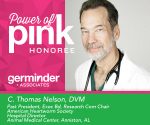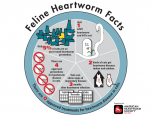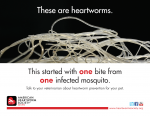Dr. C. Thomas Nelson will present his latest research on feline heartworm testing on Wednesday, September 11 9:10-9:40 a.m. at the AHS Triennial Symposium. He will also take part in a panel discussion on feline heartworm infection and moderate discussions on compliance. For the full scientific program click here. This interview has been updated from an earlier posting this year.
C. Thomas Nelson, DVM past-president, executive board member, and research chair of the American Heartworm Society (AHS), was the final Germinder20 Power of Pink Honoree to receive the award. In addition to his decades of commitment to educating veterinarians and the public about heartworm disease and prevention, Nelson is a practitioner, an active cyclist, outdoorsman and dedicated community volunteer.
He designated the $1,000 Honoree donation to the Northeast Alabama Bicycle Association (NEABA) Building Fund to drive economic development and wellness in his community. The last time we interviewed Dr. Nelson; he was hard at work renovating an historic building in downtown Aniston for NEABA’s headquarters.
We revisited with Dr. Nelson to talk about heartworm disease and prevention, parasite control, the research he will present at the upcoming AHS Triennial Symposium — and the NEABA building he just completed — Lea-Ann Germinder, Goodnewsforpets Editor and Publisher

Your research at the Sept 8-11 American Heartworm Society Triennial Symposium will focus on feline heartworm disease. Can you give us a preview?

I am working with a couple of groups to come up with a better way to diagnose feline heartworm disease in cats. The current feline heartworm testing methods for cats are not reliable, so the need for prevention is not as well understood as it should be since most veterinarians are unaware of the true risk of infection.
Right now we’re analyzing the data. We’re looking at antigen test, heat-treated antigen test, five different antibody tests, pathology, and radiology results. That is a lot of data on each cat to go through.
We are starting to see some patterns and hopefully it will maybe give us some insights. We will be ready to present the findings at the Triennial Symposium.
April is designated as Heartworm Awareness Month, but as we head into the American Heartworm Society Symposium, there is much to discuss about heartworm prevention. There’s probably been a lot of changes since we worked together on feline heartworm awareness with the KNOW Heartworms campaign several years ago sponsored by Pfizer (Zoetis), the American Heartworm Society and the American Association of Feline Practitioners. What’s new?
The KNOW Heartworms campaign was really an excellent campaign and we raised the awareness about heartworm disease in cats. People recognize the term HARD or heartworm associated respiratory disease, and we’ve seen an increase in cats on heartworm prevention, but not near to the level that we need, especially when all the data indicates cats are infected as frequently as dogs.
The problem remains that diagnosis of feline heartworms is such a complex situation. When most people think of heartworms, they think of what happens in a dog. It’s a completely different disease in a cat. I am convinced half the cats that are being diagnosed with asthma or allergic bronchitis actually have heartworm disease; it’s just been misdiagnosed.

Has anything changed in terms of awareness and acceptance that dogs need to be on heartworm preventatives?

We understand the disease so much better and have good products to prevent it, but educating pet owners that it is better to prevent than treat this deadly disease still remains a priority. The most recent data shows at the most 40% of owned dogs are on heartworm medicine.
Even of the ones that are getting heartworm prevention, probably only one third of those are getting 12 months out the year as is recommended by the Heartworm Society.
What do you think the barriers are to heartworm prevention education and pet owner compliance?
For the pet owner, this is a disease that does damage you can’t see before it’s too late. Compliance in administration of medications is a big problem in both human and veterinary medicine and heartworm prevention is one of those, “It’s easy to forget. I’m a vet and I forgot to give it to one of my own dogs and he got heartworms and I know how important it is!”
In the veterinary clinic, because of medical advances, pets are living longer and we need to make sure we discuss all the diseases that are affecting more senior animals because of extended life expectancy. There are more complex issues to discuss and things we can do for a lot of these conditions and it all has to be in a 30-minute appointment.
Preventing heartworm disease is so important I would encourage all pet owners to be prepared to ask about heartworm prevention upfront with your own veterinarian to ensure you are getting the latest information and recommendations.
Are there any new feline broad spectrum products that have come out recently?
We do have some new products that have come out for cats this past year.
There’s Revolution Plus from Zoetis. They’ve added sarolaner to selamectin, so now in addition to killing heartworms, some intestinal worms and ear mites, they’ve added a flea and tick component to it. Now you’re getting very good flea control and tick control, especially if you’re in the south central United States where cytauxzoonosis is, which is transmitted by ticks and kills cats.
There is also another new topical that does heartworm, roundworms, hookworms and tapeworm called Centragard by Boehringer Ingelheim. It contains eprinomectin and praziquantel. Tapeworms are very prevalent in cats and this product does an excellent job of treating these recurring infections.
Are there any new heartworm preventatives that are going to be on the horizon that you can talk about?
When you are involved with any kind of research you can’t talk about specifics until the products have received approval and are on the market. There are products that are still under regulatory review — some that are new variations or combinations. Some products on the market have developed resistance to isolates in certain areas of the country so industry is working on new compounds, but that is still probably a ways off. As far as actual new compounds or new classes of compounds from heartworm, that’s not expected in the near future.
Is it likely that pet owners will see more combination products? Will we see more oral or topical products?
All of the above. We will likely see more combination products for both the dog and the cat. There are challenges when you start combining multiple drugs together because of the pharmacokinetics of mixing them together, but if you can make it work and get more claims together in one product that means more convenience for the client, better compliance and ultimately more prevention.
As for oral vs. topical products, if you look at market data over the years, more oral products are given in a year than the topicals. Dog owners tend to prefer oral products. Because of the challenges of trying to get something oral down a cat, cat owners tend to go with a topical product.
There are some products you can get that are over-the-counter and make many claims. One claim is protection against mosquito bites. A pet gets heartworm after being bitten by a mosquito carrying infected heartworm larvae. Other products have claims about fleas and ticks. Do you have to dispel any myths in your clinic about the efficacy or safety of those products?

You do have to dispel rumors. First I will say when it comes to heartworm prevention, you need to stay with a product that is regulated by the Food and Drug Administration or FDA. There is no over-the-counter FDA product approved for heartworm prevention.
When you start discussing an over-the-counter product, or an all-natural product, or holistic product, there is no research to support the use of these products. They can change the batch to batch. It is just like the vitamins you and I take are not regulated by the FDA. They don’t have to do what they say they do.
When you start talking about topical fleas and ticks, some of those products are regulated by the FDA. Some of the topical flea and tick products are regulated by the Environmental Protection Agency or EPA. The EPA is looking at safety in the environment and not necessarily the safety of the animal or the efficacy of what the product does.
Another concern is pyrethroid or pyrethrins are in so many flea and tick products as an active ingredient, especially in canine products, but cats are extremely sensitive to these ingredients. Our number one toxicosis in domestic animals are cats with pyrethroid toxicity.
Pet owners may get a product that’s for a dog and think it’s okay to use it on their cat. It’s not. They are at risk for severe toxicosis. In fact, the products say right on the label, “Do Not Use on Cats.” It’s costly to detoxify the pet and get the animal through intensive care when they could have bought the right prescription product for that cat and saved both the cat and themselves what they just went through.
Bottom line, make sure you talk to your family vet about what products are out there and what he or she recommends, no matter what the source is.
Is there any specific concerns right now about other parasites?
Parasites are still a big problems in our family pets. We need to keep them under control and we have the methods and products to prevent them from not only occurring in our pets, but being transmitted to us and becoming a problem in our homes.
The Centers for Disease Control and Prevention came out a year ago with data showing that 14% of the American public are infected with roundworms. That’s three to six million people every year infected. About 50% of shelter cats have roundworms. It makes sense to have your cat checked for roundworms. That’s just one example of one parasite. We need to be viligant to keep our pets healthy to keep our family healthy.
How does a pet owner know what to give his or her pet for flea and tick control?
They need to trust their family vet, they need to talk with them and say, “What do I need to give my pet, what parasites do I have in my area?”
When we start talking about preventive medicine, everything needs to be looked at as a risk assessment. We no longer give every vaccine for every particular disease out there to every animal every year. It is the same with parasite control. Fleas are pretty ubiquitous. It’s pretty much the same flea you’re always dealing with but ticks are different regionally.
The brown dog tick is different than the lone star tick, which is different from the Gulf Coast tick. They can transmit different diseases and they respond differently to different products. For example, we are starting to see resistance to permethrin in 30% of brown dog ticks in Texas and in Florida.
What can we expect in heartworm incidence this year? Does it vary by region?

The weather patterns we see in a year are going to affect what we diagnose the next year and they do vary by region. For example, last year there were extreme drought conditions out west. That’s going to probably decrease the number of heartworm cases we see diagnosed out west from last year.
Conversely, there were some significant storm events along the East Coast last year. Then we had the hurricane that came into the panhandle of Florida and the flooding that occurred there. This year we will probably see more cases of heartworms being diagnosed in those regions because there’s a lag period from the time they were bitten to getting the adult worms to diagnosing it. It’s a minimum six to seven months. So typically we don’t start seeing them until a year later.
You are an American Heartworm Society Board Member, Chair of the Research Committee and Co-Editor of the American Heartworm Society Guidelines. Is the Heartworm Society still advocating for year-round protection of heartworm disease in every state?
In the continental United States and Hawaii, yes, we recommend year-round prevention. We know the pet needs to be protected against heartworm transmission at every stage and the only way to ensure that is with year-round protection.
If a pet gets bitten by a mosquito carrying heartworm larva, the larva is molting to the juvenile worm around day 51, 52, so even by missing one month of prevention, the larva could have reached the immature adult worm stage. Most preventives are designed to work on the larva stage, not the immature adult stage. By then it may be too late for the preventive to be effective.
There are some products that can work on immature adults if you were to miss one month, but you have to consistently give them for twelve months after that without missing another dose and without being late. But, there is no guarantee.
Heartworm prevention is basically abbreviating an infection. You’re trying to eliminate heartworms while it’s still in what’s called a tissue phase, before it actually gets into the pulmonary artery or the vascular phase. That’s what you’re trying to stop, if you kill those juvenile worms inside the vessels, yes, they don’t get to adult worms, but you will cause inflammation and you will cause some scarring and damage. That’s why it’s important that we give it every month.
Does the climate make a difference?
Yes, another reason for year-round protection are microclimates, research that I presented in the last AHS Triennial Symposium. We know the development of heartworm larva within mosquitoes is temperature dependent. This study showed that microclimates exist that would allow mosquitoes to survive in areas where we didn’t think it was possible. Alaska, you can get away with seasonal. There are parts of the United States such as rural North Dakota and Montana that you’re not going to have issues in the wintertime.
The problem is, when you look at the last census, 80% of the American public lives in urban areas. When you live in urban areas, there are microclimates where mosquitoes can survive and thrive.
Mosquitoes can get down in storm drains. They can get down in the sewer systems. They get in crawl spaces. They find places where they’re able to get away from cold temperatures.
We also continue to see changes in the mosquito vectors themselves because the Asian Tiger mosquito is migrating further and further north, as far as the Great Lakes. We’re starting to see pockets of it out west. There’s a pocket of it now in Colorado, and as it expands, this is a mosquito that lives three months and has learned to tolerate freezing temperatures. It’s an urban dwelling mosquito, so it gets into protected areas and as the weather warms up, you start going out and lo and behold, here’s a mosquito and heartworm transmission can occur.
That’s another reason why we recommend year-round, as does the FDA. You can go on the FDA website and in their consumer reports and they recommend administering year-round heartworm prevention.
On a personal note, you designated the Germinder20 Power of Pink donation to the NEABA. We’re thrilled to hear the NEABA headquarters building you were working on has been completed. What did it feel like to cross that finish line?
We all breathed a big sigh of relief when the NEABA headquarters building was finished. Seriously it felt great, and the building has been put to great use with several meetings there already. We just finished the Cheaha Challenge Gran Fondo Century & ULTRA ride which is a challenging route over the highest point in Alabama – Mount Cheaha – and then back again. We had a record number 1,100 bicyclists in town. We constructed 15-foot towers with a 46 foot truss that comprised the start finish line. Inside the towers were speaker arrays capable of broadcasting sound over a 10 acre venue.

Venue Before……

Venue After!
We had an expo area with cycling related vendors,a food truck, coffee truck and the required power systems in place to turn a parking lot into a little village. The difference this year is we had the NEABA headquarters nearby to store all our gear. We are looking forward to continuing to have more events and utilize this tremendous space.

Click here for video of the full NEABA building renovation.
Is there anything else that you would like to add about why pet owners should be concerned about protecting their dog and cat against heartworm?
One of the most important things to reinforce with pet owners is heartworm is a deadly disease. In dogs, we can treat the heartworm infection and eliminate the infection quite successfully. But, even though we eliminate the infection, there will be damage done to those vessels and to the lungs that’s longstanding and doesn’t go away. Just eliminating the worm does not mean that there’s not still disease there, because heartworm disease is basically forever.
In the cat, if they get an adult worm, we have no treatment for adult worms. Even in the cat the immature worm is going to cause significant lung lesions. All of our data now supports that our cats are being infected at the same rate as dogs.
This is something that’s very, very easy to prevent. We can prevent it in our dogs, we can prevent it in our cats, make them live longer and healthier and be healthier. These products that we’re using are also going to take care of other parasites — intestinal parasites that can potentially affect us and our children and our grandchildren. There are so many reasons to do — and I can’t think of one not to do it.

Courtesy of the American Heartworm Society (AHS). For additional kid sheets from AHS, click here.
Veterinarians and the veterinary healthcare team can register for the American Heartworm Society Triennial Symposium here.
Pet owner resources are available at the American Heartworm Society website here.
This interview has been provided for informational purposes. As discussed above, consult your veterinarian on what is best for your pet.
AHS Announces Updated Feline Heartworm Guidelines: A New Syndrome Defined
Dr. C. Thomas Nelson Named Final Germinder20 Power of Pink Honoree
A Heartworm Expert, A Community Volunteer, A Visit With Dr. Nelson Part One

